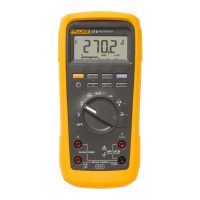Introduction and Specifications
Using the Meter Safely
1
1-3
1-1. Using the Meter Safely
Use the meter as described in this manual. Otherwise the safety features provided by the
meter might be impaired. A Warning identifies conditions and actions that pose hazards
to the user; a Caution identifies conditions and actions that might damage the meter.
Read First: Safety Information.
Read First: Safety Information
This meter complies with EN 61010-1:1993, ANSI/ISA S82.01-
1994 and CAN/CSA C22.2 No. 1010.1-92 Overvoltage Category
III. Use the meter only as specified in the Users Manual,
otherwise the protection provided by the meter may be
impaired.
X W Warning
To avoid possible electric shock or personal injury:
• Do not use the meter if it is damaged. Before use, inspect the
case for cracks or missing plastic. Pay particular attention to the
insulation surrounding the connectors.
• Inspect the test leads for damaged insulation or exposed metal.
Check test lead continuity. Replace damaged leads.
• Do not use the meter if it operates abnormally. Protection may be
impaired. When in doubt, have the meter serviced.
• Do not operate the meter around explosive gas, vapor or dust.
• Do not apply more than the rated voltage, as marked on the
meter, between terminals or between any terminal and earth
ground.
• Before each use, verify the meter’s operation by measuring a
known voltage.
• When servicing the meter, use only specified replacement parts.
• Use caution when working above 30 V ac rms, 42 V ac peak, or 60
V dc. Such voltages pose a shock hazard.
• Keep your fingers behind the finger guards on the probe when
making measurements.
• Connect the common test lead before connecting the live test
lead. Disconnect the live test lead first.
• Remove test leads from the meter before opening the battery
door.
• Make sure the battery door is closed and latched before operating
the meter.
• Use only a single 9 V battery, properly installed in the meter case,
to power the meter.

